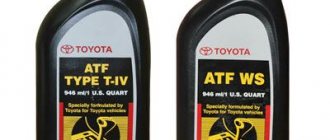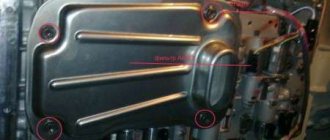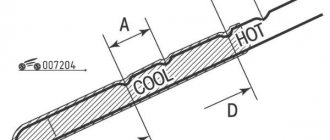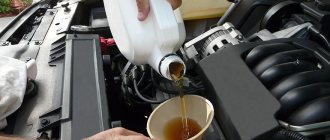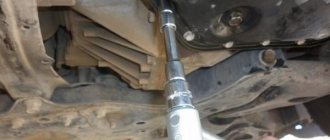The mid-size pickup truck has been produced by Toyota since 1968. Since 2015, the eighth generation of the model has been on sale. In Russia, the latest generation is officially being sold with a single diesel engine. However, diesel is a priority on this car today. So the previous generation was sold with a 2.5 and 3.0-liter diesel engine under the hood. Therefore, Hilux oil should be selected for a diesel engine.
About tolerances
Diesel engines:
- 1GD-FTV, 2GD-FTV, 1KD-FTV, 2KD-FTV.
Oil approval sheet for Toyota Hilux Diesel
Original oil
According to the car instructions for 1KD and 2KD engines, the following quality requirements are put forward: ACEA B1, API CF (possibly CD, CE, higher but not lower) SAE 5W-30. That is, the oil in the Hilux engine must be original and have a viscosity index of 5W-30, 5W-40. But it is better to opt for the first option.
| Toyota Motor Oil SN GF-5 5W-30 4 liters Article: 08880-10705 Average price: 2200 rubles 1 liter Article: 08880-10706 Average price: 650 rubles | Toyota Engine Oil 5W-40 5 liters Article: 08880-80375 Average price: 2720 rubles 1 liter Article: 08880-80376 Average price: 780 rubles |
Approved analogues by tolerance
| Petro-Canada Supreme Synthetic 0W-20 4 liters Article: unknown Average price: 2,000 rub. 1 liter Article: MOSYN02C12 Average price: 530 rubles | Valvoline Maxlife 5W-30 4 liters Article: 872370 Average price: 2050 rubles 1 liter Article: 872371 Average price: 580 rubles |
| Shell Helix HX8 5W-30 4 liters Article: 550040542 Average price: 2050 rubles 1 liter Article: 550040462 Average price: 622 rubles | Mobile 1 Full Synthetic 5W-30 4 liters Article: 152103 Average price: 2380 rubles 1 liter Article: 152104 Average price: 680 rubles |
Oil for Toyota Hilux Diesel
As we said above, oil in Toyota Hilux diesel is used with official approval from Toyota. Namely:
- Toyota Motor Oil SN GF-5 5 W-30
4 liters Article: 08880-10705
Average price: 2200 rubles
If you are interested in more budget analogues, then brands such as:
Cost is not a key factor today; rather, it is important (.) not to run into a fake. Therefore, many owners tend to use rarer oils, such as Valvoline, Wolf, Petro-Canada.
How much oil is in a Toyota Hilux engine?
Toyota Hilux oil filling volumes for diesel engines are:
- 2.5 diesel (2KD-FTV) - 6.9 liters of oil with filter.
- 3.0 diesel 1KD-FTV - 6.9 liters of oil with filter.
In addition to the oil, it is advisable to replace the cabin, air and oil filters. At the same time, it is worth purchasing branded products manufactured by Toyota.
Tip: We recommend that you always keep a small amount of engine oil in reserve, since during the operation of the vehicle it may be necessary to add fluid to the internal combustion engine.
Toyota Hilux 2.5, 2.7, 3.0, 4.0 engine oil, how much and what kind is required?
Toyota Hilux is a Japanese pickup truck, available in two- and four-door versions. However, the first generation car, released in 1968, had only a two-door body. The engine range consisted of engines of 1.5, 1.6, 1.9 and 2.0 liters. In 1972, sales of the second generation Hilux began, with engines of 1.6, 2.0 and 2.2 liters. Gearboxes are five-speed manual and four-speed automatic. The third generation machines entered the production line in 1978. For the first time, the car received a four-door body, and the engine range was replenished with engines of 1.8 and 2.4 liters. A 2.2 diesel engine also appeared, as well as a three-speed automatic transmission. In 1983, sales of the fourth generation Toyota Hilux began. The car has a petrol engine with a volume of 1.6-3.0 liters, as well as two diesel engines with a volume of 2.2-2.4 liters. The top versions received a four-speed automatic transmission. The fifth generation Toyota Hilux went on sale in 1988. The new product of that time was available with gasoline engines, as well as diesel engines, borrowed from its predecessor. The gearboxes have not changed.
The 1997 model, released in 1997, received minor changes in design, technical content and interior design. The engine range has been modernized. Production of the Toyota Hilux VI continued until 2005. The seventh generation model entered the production line in 2004. This Hilux modification was produced in Pakistan, South Africa, as well as Thailand and Argentina. In 2011, a restyled version was released and became available in Russia. However, in the Russian Federation the car was delivered only with a two-door body and all-wheel drive. There were two engines - diesel engines with a volume of 2.5 and 3.0 liters, with a power of 144 and 171 hp. With. respectively. The minimum price was 1 million 400 thousand rubles. Since 2015, the eighth generation Toyota Hilux has been sold in Russia, available for a minimum of 2 million 306 thousand rubles for a configuration with a 2.4 liter engine (150 hp).
Source
Latest generations of Toyota Hilux
Currently popular in the country are the 7th generation Toyota Hilux models, produced from 2005 to 2015, and the 8th generation that replaced them, which continues to roll off the assembly line to this day.
For the Russian market, the Toyota Hilux 7 was supplied with a 2.5-liter turbocharged engine with 144 horsepower and a five-speed manual transmission, as well as a 3-liter diesel engine with 171 horsepower and a five-speed automatic transmission.
The eighth generation is presented with a 2.4-liter turbodiesel power unit with a capacity of 150 horsepower. The car is equipped with a 6-speed manual transmission. There is also a choice of a 2.8-liter diesel engine with a turbine producing 177 horsepower.
In 2021, the concern announced restyling, and the car has undergone external changes. The updated version of the Hilux received a new radiator grille, the recognizable lines of the front bumper were changed, and the fog lights were transformed - now they are framed by chrome trim.
There are other types of motors available in different countries. So, in Thailand there are cars with a 2.7-liter power unit with 166 horsepower.
Motor oil for Toyota Hilux engine
The first mid-size Toyota Hilux pickup truck was released in 1968. It was a two-door model with a cargo bed and all-wheel drive. Eight generations of Hilux have been produced since the beginning, and the current generation has been in production since 2015. The machine has a longitudinal arrangement of the internal combustion engine and a frame structure. Thanks to its high functionality and maintainability, this pickup truck has earned enormous popularity in many countries around the world. Considering the excellent cross-country ability, it is not surprising that many third-party studios are engaged in tuning the Hilux until it turns into a real off-road conqueror. The model has been sold on the Russian market since 2010. In 2017, Hilux was named "Best Used Pickup Truck" by an international panel of experts.
Toyota Hilux in Russia
Toyota Hilux Pick Up appeared in Russia relatively recently. And this is not surprising, because the model was originally intended for American roads. In addition, the car was quite expensive for domestic consumers. However, today the vectors have changed, and the mid-size pickup truck has become one of the most popular players in the Russian automobile market.
Attention! The car turned out to be extremely successful. The pickup is durable, passable and reliable. That is why it has become so widespread in our country. Almost no one can compete with the “Japanese”.
But, like any car, Hilux requires timely maintenance. First of all, this concerns high-quality fuels and lubricants in quantities corresponding to the established standard, the manufacturer recommends replacing them every 10 thousand kilometers or every 12 months if the car drives less than the established limit between technical inspections.
However, not all oils are suitable for Toyota Hilux diesel internal combustion engines. It is important to understand what viscosity of liquid should be used in the region of operation, which company is best suited for this model and what quantity should be filled. The engine should not experience oil starvation and at the same time should not squeeze out excess, thereby violating the tightness of the power unit.
How much oil to fill in a Toyota Hilux engine
Sixth generation (N140, N150, N160, N160, N170, produced 1997-2005)
The 1997 Hilux family included two- and four-door versions, similar to the previous model. The pickup truck had a wide range of gasoline and diesel engines, coupled with manual transmission-5 or automatic transmission-4. In particular, three gasoline internal combustion engines and one diesel were available. In the USA the car was renamed Toyota Tacoma. From a design point of view, the car began to look less brutal and heavy due to its smoothed outlines, but in terms of cross-country ability, the “sixth” Hilux was no worse than its predecessor.
Seventh generation (AN10, AN20, AN30, model year – 2005-2015)
The seventh generation Toyota Hilux is a more popular model compared to the 1997 model. The car first appeared on the Russian market, and its production was carried out in Thailand, Indonesia, South Africa and Argentina. The engine range for Hilux was produced all over the world. In particular, transmissions were assembled in India, gasoline engines were produced in Indonesia, and Thailand was engaged in the production of diesel engines. A more durable spar frame was manufactured especially for the seventh generation Hilux. In addition, engineers upgraded the front double-wishbone and rear leaf spring suspension. The 2005 Hilux family included three types of cabs - Single Cab (single), Extra Cab (one and a half) and Double Cab (double). In 2012, restyling took place, as a result of which the car received a new turbine and a modified design, and a rear differential lock became available in the minimum configuration. Only the Double Cab version with all-wheel drive and reduction gear was supplied to Russia. The Russians were offered a car with two diesel engines (2.5 and 3.0 liters, 144-171 hp) and two types of gearboxes (Manual 5 or Automatic 4) to choose from.
Diesel engines (2005-2015)
- 2.5 D4D 2KD-FTV, oil volume - 6.9 liters, tolerance and viscosity - ACEA B1, API CF; 5W-30, 5W-40
- 3.0 D4D 1KD-FTV, oil volume - 6.9 liters, tolerance and viscosity - ACEA B1, API CF; 5W-30, 5W-40
Eighth generation (AN120, produced - since 2015)
In the eighth generation, the pickup truck of the same name acquired heavier shapes, became more solid and larger than its predecessor. The car received a line of 4-cylinder Global Diesel engines, a feature of which is the ESTEC concept in order to save fuel and reduce harmful emissions. The basic version of the eighth generation Hilux is equipped with a 2.4 liter diesel engine (150 hp) and a six-speed manual transmission. The most expensive option is available with a 2.8 diesel engine (177 hp) and a 6-speed automatic transmission. The pickup truck has become more luxurious not only on the outside, but also in terms of equipment. In particular, seven airbags, VSC stability control, hill descent control and trailer stabilization assistant are relevant for this model. Since 2021, a restyled version of the Toyota Hilux has been produced. The updated model received a modified radiator grille and bumper, as well as other foglights built into chrome-plated C-shaped sections.
Diesel engines (since 2015)
- 2.4 2TR-FE, oil volume - 5.6 liters, tolerance and viscosity: API SL, SN/ILSAC; 0W-20, 15W-40
- 2.8 1GD-FTV, oil volume - 7.5 liters, tolerance and viscosity: ACEA C2, 5W-30, 15W-40, API CF-4, ACEA B1; 0W-30, 5W-30.
Reviews
Alexander, Moscow region. I have a Toyota Hilux 2016 model year, version with a 2.8-liter diesel engine and an automatic transmission. A rather rare car even in the Moscow region, and therefore inspiring respect from others. From a reputation point of view, it’s not a Land Cruiser, of course, but they still let it pass on the roads - this is a kind of compensation for its impressive dimensions.
Yaroslav, Krasnoyarsk. I drive a used 2008 Hilux, version with 2.5 diesel engine and automatic transmission. The current mileage is 113 thousand km, I use the car for trips around the city and to the country. A surprisingly versatile and economical car that doesn’t care about any roads. An impenetrable suspension, an invigorating diesel engine with its roar, a spacious interior and a voluminous cargo platform would make the Hilux the car of my dreams, if not for the very scarce spare parts. After all, this generation has not been produced for a long time.
What kind of oil to fill in the Toyota Hilux engine
Original
For a new Toyota Hilux, the preferred branded engine oil is Toyota Motor Oil SN GF-5 5W-30 or Toyota Engine Oil 5W-40.
Unoriginal
If the car is used or used, then it makes sense to fill in a high-quality analogue that matches the parameters of the original oil. When choosing an analogue, it is important to pay attention to the requirements of ACEA B1, API CF/CD/CE, which are put forward for the most common 1KD and 2KD engines. For example, you can choose the following analogues:
- Petro-Canada Supreme Synthetic 0W-20
- Valvoline Maxlife 5W-30
- Shell Helix HX8 5W-30
- Mobil Full Synthetic 5W-30.
Source
What oil to use for the Toyota Surf engine
Original
Owners of petrol Toyota Hilux Surf cars prefer the original Toyota Motor Oil SN GF-5 5W-30 engine oil. As you can see, in this case the oil meets the advanced SAE viscosity indicators and API tolerance. It is important to remember that if you want to save money, you can also fill in a more affordable original fluid with an ILSAC GF-4 or GF-3 approval. Also, instead of API-SN, API-SM is suitable for older motors.
Unoriginal
You should be careful when choosing an analogue, since a certain oil is suitable for different modifications of Surf. For example, for the third generation Toyota Surf, which is very common in Russia, produced in 1996, semi-synthetic SAE 10W-30 with API-SG + EC1 approvals is recommended. This can be all-season oil, and when operating a 2002 Toyota Surf. in the winter season, you should fill in semi-synthetic with parameters SAE 5W-30 and API - SJ + EC 1. If the machine is operated mainly in the warm season, then you can use all-season oil. Below are the most suitable analogues.
How much oil does a Toyota Hilux engine need?
Gasoline and diesel engines are found in cars; the capacity of the sump depends on the generation and method of ignition of the working mixture. Information about the volume is indicated in the operating instructions.
There is a steel dipstick rod on the side of the crankcase, which allows you to check the lubricant level in the sump. It is not allowed to operate the power unit with either low or excessive amounts of oil.
Sixth generation
On cars with N140-170 bodies (manufactured from 1997 to 2004), the following engines were used:
- petrol 2-liter 1RZ-E, holding 4.3-4.6 liters of lubricant;
- petrol 4-cylinder 3RZ-FE, equipped with a 5.4-liter sump;
- V-shaped 3.4-liter 5VZ-FE, maintenance requires at least 5.2 liters of lubricant;
- 3-liter 1KZ-TE and 1KD-FTV with trays with a capacity of 7 and 7.5 liters, respectively;
- autodiesels 2L-TE and 5L, requiring from 5.5 to 6.5 liters of material.
The sixth generation cars used a 2-liter gasoline engine.
Seventh generation
On cars manufactured 2004-2015. there are power units:
- diesel engines 2KD-FTV and 1KD-FTV with a supercharging system, having pallets of 6.9 and 7.5 liters, respectively;
- petrol 1TR-FE and 2TR-FE, holding 5.5 and 5.6 liters of lubricant.
Diesel engines until 2015
Compression ignition engines fitted to Hilux before 2015 require between 5.5 and 7.5 liters of lubricant depending on cylinder displacement. For early models 2L-TE and 5L, you can use synthetic materials with a manufacturer’s approval of at least API CD; later versions 2KD-FTV and 1KD-FTV require oil of at least API CF standard (viscosity 5W-30).
Eighth generation
For the VIII generation, supercharged diesel engines 2GD-FTV and 1GD-FTV with a cylinder capacity of 2.4 and 2.8 liters, respectively, began to be used, characterized by reduced fuel consumption and a modified power and torque curve. Pickup trucks with a 2.7-liter 2TR-FE gasoline unit developing 166 hp were supplied to a number of markets. With. Synthetic oils with a viscosity of 5W-30 or 0W-30 with ACEA C2/E9 and JASO DL-1 approvals could be used for the lubrication system, providing reduced fuel consumption and easy starting at low air temperatures.
The eighth generation uses a supercharged diesel engine.
Diesel since 2015
Since 2015, Toyota has been offering in-line 4-cylinder engines with compression ignition:
- 150-horsepower 2GD-FTV, providing for filling 7.5 liters of oil;
- 200-horsepower 1GD-FTV, characterized by an increased cylinder capacity and a lubrication pan, unified with the 2GD-FTV (capacity 7.5 l).
How much oil is needed for axles
The amount of oil in the differential boxes depends on the generation and location of the axles; information is indicated in the instructions. For example, on the VI generation the capacity is 1.15 and 2.45 liters for the front and rear axles, respectively. It is allowed to refill with synthetic fluid that meets the API GL-5 standard and has a viscosity of 85W-90.
For non-locking LSD differentials, 75W-90 viscosity material can be used.
Which oil to choose for Toyota Hilux
To refuel power units, you can use both original oil and materials from third-party manufacturers (subject to compliance with the requirements). It is recommended to purchase liquids from large retail outlets or from official representatives, which reduces the risk of purchasing counterfeit products. When selecting, you should take into account the crankcase capacity. Manufacturers offer oil in cans with a capacity of 1, 4 or 5 liters. The material is also supplied in 200-liter steel barrels for bottling.
Original oil
Toyota is not involved in the oil refining industry; the oil supplied is produced by Exxon Mobile. Toyota Genuine Motor Oil material is packaged in original containers that have several degrees of protection against counterfeiting.
Toyota Genuine Motor Oil is packaged in original containers.
The fluids have viscosities from 0W-20 to 10W-43 and comply with API SL..SN Plus for gasoline engines and API CF..CF-4 for diesel units. For Hilux with gasoline units, it is recommended to use standard 0W-20 oil; engines with compression ignition show the best fuel economy results using 5W-30 lubricant.
Factory recommendations for transmission oils:
- for automatic transmissions, use Toyota Genuine ATF WS (filling volume from 8.5 to 9.5 liters excluding flushing);
- Genuine Manual Transmission Gear Oil API GL-3 (GL-4) 75W-90 (volume from 2.2 to 2.7 l) is suitable for mechanical transmission;
- for the transfer gearbox you should use Toyota Genuine Transfer Gear Oil LF;
- Toyota Genuine Differential Gear Oil ”LT 75W-85 GL-5 is suitable for differentials.
High-quality analogues
The vehicle owner can use lubricants from third-party suppliers that meet the requirements of the Hilux pickup factory. High-quality materials are supplied by Shell, Castrol, Mobil, Elf or Liqui Moly.
The market for motor and transmission oils also includes products from Russian brands (for example, Lukoil).
Synthetics for Toyota - to use or not to use?
The recommendations in this article will help you understand this often complex issue.
What you need to know when choosing oil for Toyota
When choosing motor oils intended for lubricating engine parts from a huge range of synthetic oils, there are a few things you need to know.
First, some notes about synthetic oil. This oil has fewer impurities than conventional motor oil.
In addition, it often has better high temperature properties, marginally better viscosity, and is generally more resistant to wear than other motor oils.
It would seem obvious that synthetic motor oil is better for your engine. But don't jump to conclusions.
Choosing a synthetic motor oil depends on several things:
1. The first reason is your engine oil change interval.
As we have already said, synthetics can work in quite harsh conditions, which means, as a result, such oil quickly loses its properties as the load on the engine increases.
But unlike mineral water, such oil, thanks to the modifiers it contains, does not give a single chance of engine part failure. Simply put, a synthetic set provides you with some safety nets.
2. Low car mileage.
Just like with high drain intervals, synthetic oil gives you the advantage of extended drain intervals, so if your mileage has gone into the 5 digits on the odometer, then it's the right oil for you.
Unlike conventional motor oil, synthetic oil, under normal conditions, can operate without losing its properties for more than 6 months before it begins to become less effective.
3. Aggressive driving. As mentioned earlier, synthetic oil is more resistant to adverse conditions and will perform better in those conditions than conventional mineral motor oil.
Additional Tips
To ensure maximum service life, use lubricants that meet the vehicle manufacturer's requirements. When carrying out maintenance, the operating conditions are taken into account. Reusing the oil filter is not allowed, since the element is already clogged with wear products and does not provide separation of fine particles.
What to pour in summer and winter
The introduction of synthetic materials allows you to operate the car throughout the year without seasonal maintenance. The owner of a pickup truck should only take into account the requirements of the manufacturer and climate conditions. Excessively thin or thick engine or transmission oil worsens the operating conditions of the units, accelerates wear, or leads to increased fuel consumption.
Liquid oil leads to increased fuel consumption.
Synthetic or natural
Hilux car engines require synthetic-based oil (pickup trucks from the 1990s can be operated on semi-synthetic materials). The design parts are not designed to use mineral lubricant. An automatic transmission should be filled with a special ATF fluid, and for a manual transmission, axles and gearboxes, mineral or synthetic oil can be filled. The disadvantages of natural-based materials include a high pour point and a short service life due to the low concentration of additives.
How to change oil in Hilux
To change the lubricant in a pickup truck engine, you must:
- Warm up the engine and transmission units and drive the car onto a horizontal overpass or onto an inspection hole in a garage.
- Open the hood and wipe the filler cap with a clean, dry cloth.
- Unscrew the filler cap, and then remove the protection of the engine and transmission pans.
- Clean the crankcase body around the plug and unscrew the plug, placing a container under the hole to collect waste.
- Unscrew the filter housing (for example, using a chain puller or a piece of coarse sandpaper).
- Wait for the waste to drain and pour 50-70 ml of lubricant into the new filter, apply a thin layer of liquid to the rubber o-ring. Old oil should not contain chips or traces of antifreeze (coolant can get in if the block walls are damaged or the gaskets are destroyed).
- Install the filter element onto the fitting and tighten the drain plug.
- Fill the crankcase with fresh oil (with the appropriate quality class), checking the level on the dipstick.
- Close the plug and perform a test run. The oil pressure lamp should go out when the crankshaft is cranked with the starter or immediately after the engine starts running.
- Reinstall the protective screens.
Changing the oil for a Toyota Hilux automatic transmission involves draining the waste while simultaneously supplying fresh fluid. The technique allows you to remove wear products and contamination from the internal cavities of the unit. The procedure is carried out manually or using a special installation. The quality of the working fluid is assessed visually. After refueling, you should switch the contacts in the diagnostic connector and conduct a temperature test (necessary for a final check of the oil condition).
There are plugs in the manual transmission and in the rear axle for draining and refilling lubricant. The work is carried out on heated units; before unscrewing the plugs, a layer of dirt should be removed from the crankcase. The liquid is drained over 10-15 minutes, and a transmission syringe is used to fill fresh material. At the same time, check the condition of the fluid in the transfer case. There are holes with threaded plugs for draining and filling transmission oil. Filling is carried out using a transmission syringe with an extension tube at the tip.
How to check the oil level
A steel dipstick allows you to determine how much lubricant is in the engine sump.
To check you need:
- Turn off the engine, wait 2-3 minutes, and then remove the rod and wipe with a cloth.
- Insert the dipstick all the way and remove it. The permissible minimum and maximum oil marks are marked on the surface of the tool. The level must be in the center; no emulsion is allowed on the dipstick (formed when antifreeze gets into the crankcase).
To check the amount of oil in the transmission units there are control plugs; the oil must reach the lower edge.
Check the oil level with a steel dipstick.
To check the fluid level in the Hilux automatic transmission, you need to warm up the engine and move the selector to all positions. Then you should set the lever to the neutral position and unscrew the control plug (the engine should be running). At a normal level, individual drops of liquid will flow out of the hole; excess oil should come out of the crankcase when checked.
If the fluid does not flow, then you should add the material using a syringe through an additional hole on the side of the automatic transmission housing.
Changing oil on Hilux
- Warm up the engine for about 5 minutes. Cold oil causes poor flow from the engine; as a result, a lot of dirty oil may remain, which you will eventually mix with new oil. This will degrade the performance of the new oil.
- To access the bottom of the car, it would be ideal to have an inspection hole, but in the absence of one, a regular jack with stands will do. Some models may have engine crankcase “protection” installed. It needs to be removed to access the drain plug.
- For a better “drain” of waste fluid from the crankcase, unscrew the filler plug of the neck and you can also pull out the dipstick. The oil drains faster if there is a through hole.
- We substitute a basin or any other container that can hold 5 liters of waste.
- We unscrew the drain plug with a wrench (it is better if the ratchet wakes it up). It is best to immediately expect that the oil will be hot. At this stage of work you need to be most careful.
- After completely draining the old dirty oil, which is black in color, remove the basin to the side.
- An optional item is flushing the engine with a special flushing liquid. You will be surprised at the black oil that comes out with this liquid. This liquid is very easy to use. We fill it into the engine, after tightening the drain plug of course. We start the car for 3-5 minutes. At the same time, we drive and heat our liquid on an old oil filter. Afterwards, we turn it off and pour it into a free container.
- We replace the oil filter with a new one. Before installing the new filter, pour about 100 g of fresh oil into it and also lubricate the rubber O-ring on it.
- Fill in new oil. Having made sure that the drain plug is screwed in and a new oil filter is installed, we can begin to fill in new oil using the dipstick as a guide. The level should be between the minimum and maximum marks. Also, you need to remember that after the first start of the engine, some oil will leave and the level will drop.
- Recheck the oil level using the dipstick after the first start. Let the engine idle for about 10 minutes.
Video materials
Spread the love
Replacement interval
The manufacturer requires replacing the engine oil and filter annually or every 10 thousand kilometers. Maintenance of a manual or automatic transmission and transfer gear is not provided, but the level and condition of the lubricant should be checked every 4 years or 40 thousand km. The oil in axle differentials is checked once every 2 years. The Toyota concern requires changing the lubricant every 40 thousand kilometers or after 48 months of operation. If dirt or water is found in the crankcases, extraordinary maintenance is carried out.


